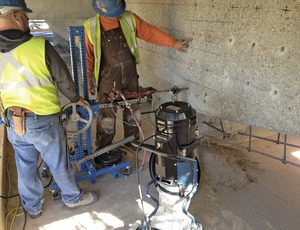Concrete Drill Jig Makes Work Less Painful

Having made overhead concrete drilling easier with an innovative, upside-down drill press, Dr. David Rempel and his University of California, San Francisco research team have turned their attention to the physical demands of drilling horizontally and at other angles.
Their efforts have yielded a new universal drilling jig that is designed for dowel and rod work and drilling large-diameter, ¾-in. to 1.5-in. holes for anchor placement in rock and concrete.
Rempel, who heads UCSF's ergonomics program, says the new jig addresses two interrelated construction issues.
"Some projects require anywhere from 10,000 to 40,000 holes using a 30- to 40-lb rock drill or a 30-lb hammer-drill," Rempel explains. "Not only do the vibrations and stress of holding the drill take a toll on the human body, the work itself becomes a real project bottleneck. We wanted to find a way to isolate workers from the weight and vibration load and make them more productive."
Designing the Jig
Using the overhead drill press as a starting point, Rempel and his team adapted the design to horizontal applications by increasing the jig's weight to a minimum of 50 lb. Along with providing a more solid connection to the ground, the heavier base can accommodate multiple drills that operate simultaneously with the bits spaced four to 14 in. apart.
Through trial and error, the team also crafted a spring-loaded saddle to direct the drill's energy to the tip of the tool, rather than back to the operator.
Introducing the spring loading also improved the bit's cutting speed and productivity, Rempel says, adding, "We also developed a system to quickly and easily change the drilling angle, providing full 180° capability."
The design also addresses the problem of dust. Because horizontal drilling generates more silica particulates than drilling at other angles, Rempel and his team experimented with various methods to capture dust. Working with drill manufacturer Hilti and Dust Control USA, the team developed a shroud-vacuum system that collects dust at the tip.
Research on the system's performance, published earlier this year in the Journal of Occupational and Environmental Hygiene, found that operator exposure to airborne silica was reduced by 94%, reaching a level well below the National Institute for Occupational Safety and Health's recommended exposure limit of 0.05 milligrams per cubic meter.

